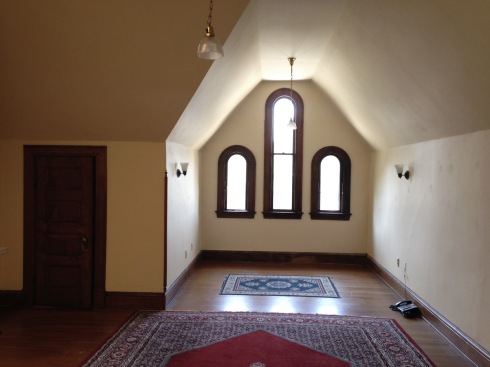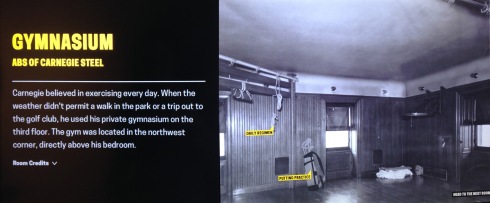It’s always been a bit of mystery, why this room on the 3rd floor of Rhodes Hall is called the “Gymnasium.” It resembles nothing of a gym today and even so, wouldn’t heavy exercise equipment be more suited to a basement? One of our volunteer tour guides even speculated on the regular that he believed it was a reference to the German “Gymnasium”—an academic grammer school. This theory that it was used as a school room could be justified by the fact that the Rhodes grandkids (Rhodes and Wilmotine Perdue) lived here for a time and visited frequently when their mother (Louanna Rhodes Perdue) remarried.
In previous attempts to research the matter I’ve come up empty-handed but recently I’ve visited both the Biltmore Estate and the Carnegie Mansion in New York and the realization that both of these grand homes for retired wealthy gentlemen at the turn of the century had private gyms encouraged me to delve back into the matter.
CULTURE OF HEALTH
The notion that we take responsibility for our own health—by eating right, breathing fresh air, and getting enough sleep and exercise—has been around for much of human history, since Hippocrates published books on regimen and the Greeks started the Olympics (from “Excercise is Medicine: a Historical Perspective”. The emphasis on exercise and health has fluctuated in importance, resurfacing it seems, during eras of prosperity, when humans had time to step back from basic survival and develop more philosophical pursuits and high individualistic ideals, such as during the Renaissance.
The Industrial Age in Europe and America brought about more economic prosperity and further advancement in medicine, which at that time was mostly focused on preventative health. In Germany, Friedrich Ludwig Jahn, “the father of modern physical education as we know it today” was “a fervent German nationalist, and believed that the best kind of society was one that had established standards of physical strength and abilities. The first Turnplatz, or open-air gymnasium, was opened by Jahn in Berlin in 1811, and the Turnverein (gymnastics association) movement spread rapidly.”(<a href="http://www.newworldencyclopedia.org/entry/Physical_education">New World Encyclopedia)
In America, the importance of physical education seems to have gained significant ground in the late 1800s. By the 1880s, the "physical education" movement led to the formation of a professional group, the American Association for the Advancement of Physical Education, signifying renewed attention on the importance of maintaining personal physical health in the field of medicine.
With the social movement of physical education, it should come as no surprise that the well-read and wealthy philanthropists of the Gilded Age would have taken an ardent interest in their own health as well. The ideals of social reform for these leaders were not limited to the masses, they maintained high expectations of themselves and their family members as well. Responsibility for one’s own health fit perfectly with the individualistic ideals these men and women set for themselves and society at large.
 The earliest evidence of a private gym in America might be the gym at the c.1870s Hegeler Carus Mansion in LaSalle, Illinois (I’d never heard of it either). One self-described fan of 19th century physical culture described it:
The earliest evidence of a private gym in America might be the gym at the c.1870s Hegeler Carus Mansion in LaSalle, Illinois (I’d never heard of it either). One self-described fan of 19th century physical culture described it:
The mansion was built during the 1870s and the gym was part of the original plans. It’s a large space, 35.5′ x 17′ and the ceilings are roughly 25′ in height. Along with a collection of 35 wooden dumbbells and 4 large Indian clubs hanging from racks on the walls, it also houses the remnants of a Victorian rope-and-pulley weightlifting system, two large gymnastics ladders and support platforms, a horizontal bar of adjustable height, a set of parallel bars, “flying rings” hanging from the ceiling, a c1920 electric exercycle and miscellaneous bits of sports equipment (wooden stilts and skis, etc.) (ArtofManliness.com)
 The gym at George Vanderbilt’s Biltmore Mansion (c.1895) is also located in the basement next to the indoor swimming pool. Swimming pools at this time were also strictly for health and sport, not the leisure and play we mostly associate with pools today.
The gym at George Vanderbilt’s Biltmore Mansion (c.1895) is also located in the basement next to the indoor swimming pool. Swimming pools at this time were also strictly for health and sport, not the leisure and play we mostly associate with pools today.
However, it is Andrew Carnegie’s gymnasium that most resembles the gymnasium at Rhodes Hall. Andrew Carnegie, like Amos Rhodes was a self-made businessman. Both men built their respective “mansions” late in life, a retreat on the northern reaches of their respective cities from which they could still conduct business in their retirement (though Carnegie did raise a daughter here, she wasn’t born until he was in his 60s). Their mansions are extremely modest in comparison to the Biltmore which was built for hosting guests, partying and raising a young family. Perhaps for this reason, the addition of a swimming pool was just too extravagant, and their gymnasiums were located in the privacy of the 3rd floor.
Of course, the 3rd floor at Rhodes Hall was also home to Mr. Rhodes’ billiard table and a smoking room, it seems the household amenities of the wealthy over a hundred years ago are not far from those of today.








Leave a comment